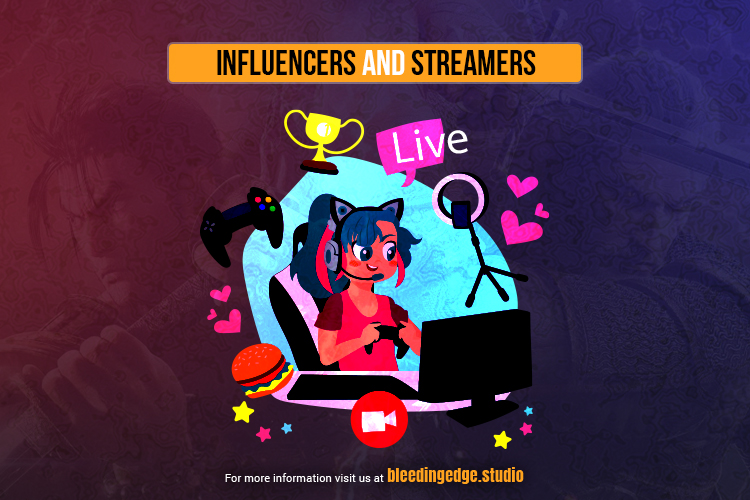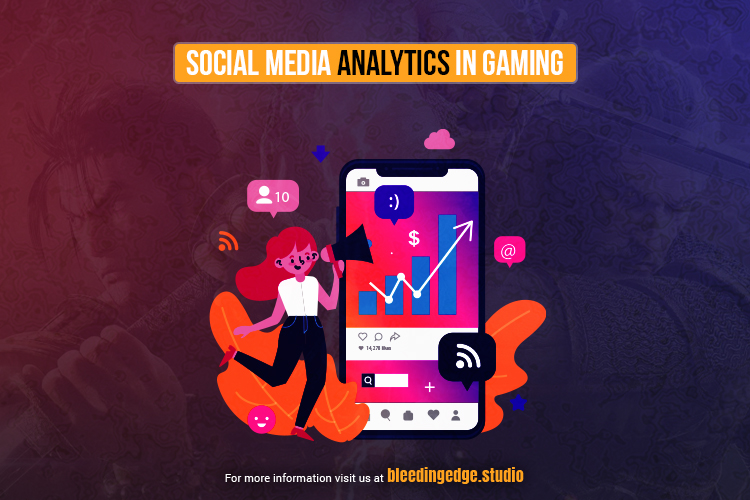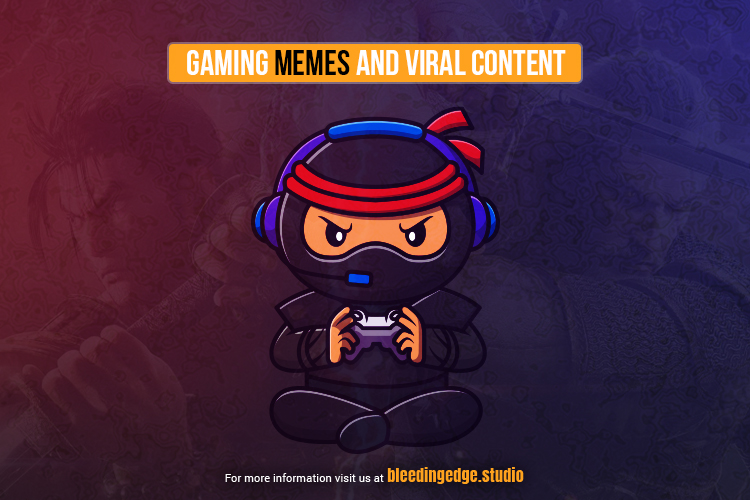Introduction:
In the ever-evolving world of entertainment and technology, the intersection of Social Media in Gaming has become a powerful force, transforming how gamers engage with each other and the gaming industry. Social media platforms like Facebook, Twitter, Instagram, and Twitch have seamlessly integrated into the gaming experience, shaping how players connect, share experiences, and participate in the gaming community. This article gives the multifaceted role of social media in gaming, from fostering camaraderie to influencing game development and marketing strategies for Social Media in Gaming.
1. Community Building and Engagement:
Social media platforms have become virtual access spaces for gamers, allowing them to connect with like-minded individuals worldwide. Facebook groups, Twitter threads, and gaming forums provide platforms for players to share tips, discuss strategies, and celebrate victories. This sense of community goes beyond the gaming console or PC, creating a global network of gamers who can relate to each other’s experiences, fostering a sense of belonging and camaraderie.
2. Live Streaming and Content Creation:
The advent of live stream platforms, such as Twitch and YouTube Gaming, has redefined how gamers share their experiences. Gamers can now broadcast their gameplay in real-time, allowing audiences to watch, comment, and interact with the streamer. This content creation has not only given rise to a new breed of online celebrities. Still, it has also created opportunities for aspiring gamers to demonstrate their skills and personalities, contributing to the democratization of gaming content.
3. Influencing Gaming Culture:
Social media platforms play an important role in shaping gaming culture. Memes, trends, and viral challenges related to specific games can spread like wildfire, influencing the broader gaming community and even impacting the development of future games. The instantaneous nature of social media allows gamers to share their opinions, critiques, and suggestions with developers, creating a dynamic feedback loop that can influence game design and features.
4. Marketing and Esports Promotion:
Social media has become an integral part of marketing strategies for game developers and publishers. Teasers, trailers, and announcements can quickly go viral, generating hype around upcoming releases. Additionally, esports events, with their professional players and competitive tournaments, have found a natural home on platforms like Twitter and Instagram, providing a global stage for competitive gaming and expanding the reach of esports to new audiences for Social Media in Gaming.
5. Brand Collaborations and Sponsorships:
The collaboration between gaming influencers and brands on social media has become a lucrative avenue for both parties. Brands recognize popular gamers’ potential reach and influence, leading to sponsorships, merchandise collaborations, and promotional campaigns. This not only boosts the income of gaming content creators but also introduces new products and services to the gaming community.
6. Influencers and Streamers as Community Leaders:
In gaming, influencers and streamers hold a unique position as community leaders. These individuals amass many followers on Twitch, YouTube, and Instagram through engaging content, charismatic personalities, and exceptional gaming skills. The influence of these gaming personalities extends beyond mere entertainment; they become trendsetters, opinion leaders, and sources of inspiration for their followers.

Influencers and streamers often leverage social media platforms to interact directly with their audience. Q&A sessions, polls, and interactive challenges foster community engagement, making followers feel like active participants rather than passive spectators. The personalized connection between influencers and their audience contributes to the overall sense of community within the gaming ecosystem for Social Media in Gaming.
7. Monetization Opportunities and Sponsorships:
The popularity of influencers and streamers has attracted the attention of brands seeking to tap into the vast gaming audience. These content creators have diversified their revenue streams, utilizing social media platforms to secure sponsorships, brand deals, and partnerships. From promoting gaming peripherals to collaborating with energy drink brands, influencers, and streamers play a pivotal role in shaping the marketing landscape within the gaming industry.
Social media monetization has also allowed influencers to turn their passion for gaming into a sustainable career. Platforms like Twitch enable viewers to support their favorite creators through subscriptions, donations, and bits, creating a direct financial relationship between influencers and their audience for Social Media in Gaming.
8. Exclusive Content and Behind-the-Scenes Insights:
Social media offers influencers and streamers a platform to share exclusive content and behind-the-scenes insights into their gaming lives. This could include peeks of upcoming projects, unfiltered reactions to games, or glimpses into their personal lives. Such content humanizes these figures, making them more relatable to their audience and deepening the connection between creator and fan for Social Media in Gaming.
Platforms like Instagram Stories and Twitter allow influencers to share real-time updates, fostering a more immediate and intimate connection with their followers. This level of transparency contributes to the authenticity that many gamers appreciate in their favorite influencers for Social Media in Gaming.
9. Challenges and Collaborations:
Social media platforms are breeding grounds for gaming challenges and collaborations initiated by influencers and streamers. Whether it’s a speedrun challenge, a cooperative playthrough, or a creative in-game endeavor, these events captivate the gaming community’s attention, sparking discussions and shared experiences among followers.
Collaborations between influencers introduce followers to new gaming content, personalities, and playstyles. This enriches the audience’s gaming experience and strengthens the sense of unity within the community for Social Media in Gaming.
10. Navigating the Ups and Downs:
Influencers and streamers often share not only their triumphs but also their struggles on social media. From facing challenging levels to discussing mental health issues, these content creators create a space where vulnerability is embraced. This openness fosters empathy within the community, reminding followers that even their gaming idols face setbacks and obstacles for Social Media in Gaming.
In conclusion, influencers and streamers wield considerable influence in the gaming landscape through their social media presence. As they continue to shape and define the gaming community, their impact on trends, brand partnerships, and community engagement is likely to evolve, further intertwining the worlds of gaming and social media. The symbiotic relationship between influencers, streamers, and their audiences exemplifies the dynamic nature of this digital ecosystem for Social Media in Gaming.
Social Media Analytics: A Tool for Understanding the Audience:
The integration of social media analytics has become indispensable for game developers, publishers, and influencers alike. These analytics provide invaluable insights into audience demographics, engagement metrics, and sentiment analysis, enabling stakeholders to make informed good decisions about their content, marketing strategies, and community-building initiatives.

By analyzing the data generated on social media platforms, gaming companies can identify trends, understand player preferences, and anticipate the needs of their audience. This data-driven approach helps to tailor gaming experiences, create content that implements with the community, and develop games that align with player expectations for Social Media in Gaming.
1. Measuring Influencer Impact:
For influencers and streamers, social media analytics play an important role in assessing the impact of their content. Metrics such as reach, engagement rate, and audience demographics provide influencers with a comprehensive understanding of their audience’s preferences. This data helps creators refine their strategies, optimize content for maximum impact, and attract collaborations and sponsorships that align with their audience’s interests.
Gaming companies often leverage social media analytics to measure the effectiveness of influencer marketing campaigns. They can track the progress and engagement of sponsored content, ensuring a return on investment and gauging the overall success of the collaboration for Social Media in Gaming.
2. Data-Driven Marketing Campaigns:
The gaming industry’s reliance on social media analytics extends to the development and execution of marketing campaigns. By studying user behavior, preferences, and responses to previous campaigns, marketing teams can craft targeted and personalized strategies to promote new releases, updates, or events.
Social media analytics also allow for A/B testing, where different marketing approaches are compared to identify the most effective strategies. This iterative process ensures that marketing efforts are continuously refined based on real-time data, maximizing their impact on the gaming community for Social Media in Gaming.
3. Enhancing Player Engagement:
Understanding player engagement is a crucial aspect of social media analytics in gaming. Gaming companies can gauge the community’s response to announcements, updates, and in-game events by monitoring likes, shares, comments, and other interaction metrics. This information is instrumental in refining future content releases and fostering ongoing player engagement.
Additionally, social media analytics help identify influencers and content creators who significantly impact player engagement. By partnering with these influential figures, gaming companies can increase their reach and establish a more direct connection with their target audience for Social Media in Gaming.
4. Managing Reputation and Responding to Feedback:
Social media analytics also play an important role in reputation management for gaming companies. By monitoring social media channels, companies can track sentiment analysis and promptly address issues or concerns the community raises. This proactive approach helps resolve problems and demonstrates a commitment to listening and responding to player feedback for Social Media in Gaming.
In conclusion, social media analytics have become integral to the gaming industry’s toolkit. As technology advances, data-driven insights will likely continue to evolve, providing new opportunities for gaming companies, influencers, and streamers to enhance their strategies, improve player experiences, and strengthen the bond with their audiences. The symbiotic relationship between social media and gaming analytics exemplifies the industry’s commitment to staying connected and responsive to the ever-changing landscape of player preferences and behaviors.
The Rise of Gaming Memes:
In the age of social media, gaming memes have emerged as a cultural phenomenon, providing a shared language that transcends geographical and cultural boundaries within the gaming community. Memes related to specific games, characters, and in-game situations have the power to go viral rapidly, creating a sense of unity and humor among gamers worldwide.

Platforms like Reddit, Twitter, and Instagram serve as hotbeds for creating and disseminating gaming memes. These humorous images, videos, or text snippets often capture relatable moments, inside jokes, or satirical commentary on the gaming experience. The viral nature of memes contributes to the organic growth of gaming culture, influencing how gamers perceive and interact with various titles for Social Media in Gaming.
1. Community-Building Through Humor:
Gaming memes play a crucial role in community-building by fostering a shared sense of humor and identity among gamers. When a meme resonates with players, it becomes a point of connection, sparking conversations and interactions within the community. Memes create a lighthearted atmosphere where players can bond over shared experiences, frustrations, or triumphs in their gaming journeys.
Social media platforms give the ideal environment for rapidly disseminating gaming memes. Gamers can easily share, comment on, and remix memes, amplifying their impact and ensuring that a particular meme becomes a part of the broader gaming culture for Social Media in Gaming.
2. Viral Challenges and Trends:
Beyond memes, social media platforms often witness the rapid spread of gaming-related challenges and trends. These challenges can take various forms, from speedrunning competitions to creative in-game tasks that players are encouraged to undertake and share. The participatory nature of these challenges transforms gaming into a social activity, enabling players to showcase their skills and creativity to a broader audience.
Viral challenges and trends contribute to the sense of a dynamic and evolving gaming community. Players come together to celebrate shared achievements, pushing the boundaries of gameplay and inspiring others to join in on the fun. Social media serves as a stage for these challenges, allowing them to gain traction and visibility quickly for Social Media in Gaming.
3. Meme Influence on Game Development:
The widespread adoption of gaming memes on social media has not gone unnoticed by game developers. Some developers actively engage with meme culture, incorporating popular memes such as Easter eggs or references into their games. This interaction between developers and the community showcases awareness and responsiveness to the evolving language and humor within the gaming world.
Furthermore, the virality of memes can influence game development decisions. Developers may take note of memes related to glitches, bugs, or specific aspects of gameplay, using this feedback to inform patches, updates, or future releases. The collaborative relationship between gamers and developers, facilitated by social media, allows for a more dynamic and responsive gaming ecosystem for Social Media in Gaming.
4. Meme Marketing and Promotion:
Recognizing the power of gaming memes, marketing teams within the gaming industry have started incorporating meme culture into their promotional strategies. Memes can create buzz around upcoming releases, generate excitement for in-game events, or promote community engagement. Leveraging memes in marketing campaigns adds a layer of relatability and authenticity, resonating with the humor and sensibilities of the gaming audience.
In conclusion, gaming memes and viral content have become integral to social media, shaping how gamers communicate, bond, and engage with the broader gaming community. The dynamic and evolving nature of meme culture reflects the vibrancy of the gaming world, demonstrating the profound impact of social media on the shared experiences and identity of gamers worldwide.
5. Gaming Communities and Subcultures:
2. Social media allows for forming specialized gaming communities and subcultures based on specific genres, platforms, or interests. Whether it’s a subreddit dedicated to a particular game or a Discord server for esports enthusiasts, these communities provide niche spaces for in-depth discussions and shared passions for Social Media in Gaming.
6. Education and Tutorials:
2. Gamers often use social media for educational content, such as tutorials, walkthroughs, and strategy guides. Platforms like YouTube enable content creators to share their expertise, helping others improve their skills, overcome challenges, and deepen their understanding of game mechanics for Social Media in Gaming.
7. User-Generated Challenges and Contests:
4. Social media platforms provide a stage for users to create and participate in gaming challenges and contests. Whether it’s a screenshot contest, a creative building challenge, or a speedrunning competition, these user-generated events add layers of excitement and friendly competition to the gaming community.
The relationship between social media and gaming is a multifaceted tapestry encompassing communication, community-building, cultural exchange, and creative expression. As both social media platforms and the gaming industry continue to evolve, this symbiotic relationship will likely give rise to new trends, innovations, and opportunities for collaboration within the expansive gaming world for Social Media in Gaming.
Summary:
Social media has woven itself into the fabric of the gaming world, playing a crucial role in connecting gamers, shaping gaming culture, and influencing the industry at large. As technology grows and social media platforms evolve, the relationship between social media and gaming will likely become even more intricate, fostering new opportunities for connection, collaboration, and creativity within the ever-expanding gaming community for Social Media in Gaming.
The role of social media in gaming is a dynamic and multifaceted phenomenon that has transformed the gaming landscape in numerous ways. Integrating social media platforms into the gaming experience has led to global communities facilitated by influencers, streamers, and the sharing of gaming-related content. These platforms have become virtual hubs for gamers to connect, share expertise , and build a sense of camaraderie.
Influencers and streamers, as community leaders, have harnessed the power of social media to engage with their audience, secure sponsorships, and shape gaming culture. The relationship between social influencers and their followers goes beyond mere entertainment, with influencers often providing behind-the-scenes insights, collaborating with others, and even addressing personal challenges, creating a more authentic connection.
Social media analytics have become crucial tools for game developers, marketers, and influencers. These analytics provide valuable insights into audience demographics, engagement metrics, and sentiment analysis, enabling stakeholders to make informed decisions, refine strategies, and enhance player experiences for Social Media in Gaming.
Gaming memes and viral content play a significant role in shaping gaming culture and community identity. Memes, challenges, and trends spread rapidly on platforms like Reddit, Twitter, and Instagram, creating shared humor and inside jokes among gamers. The influence of memes extends to game development, with developers incorporating popular memes into their games and marketing teams leveraging meme culture to promote releases and events.
Social media and gaming have created a symbiotic relationship beyond marketing and community-building. Social media has become an integral part of the gaming experience, influencing game development, marketing strategies, and the overall culture within the gaming community. This relationship will likely evolve as technology advances, presenting new opportunities for connection, collaboration, and creativity in the ever-expanding gaming world for Social Media in Gaming.
For more topics, see https://bleedingedge.studio/blog/

